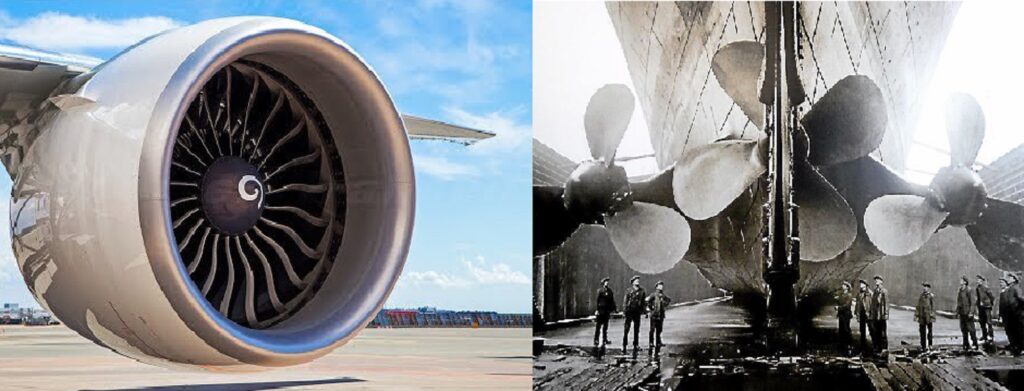
Things are not as simple as they may seem cursorily. Lets dive in to get the actual facts!
Maximum thrust (force) exerted by the most powerful version of a single Boeing 777 engine (GE90–115B) is 115,540 lbf i.e. 513.9 kN.
The maximum power (P) of 3 Titanic Engines was 46,000 HP i.e. 34,302,194 W. Top speed (V) of Titanic was 23 knots i.e. 11.83 m/s. Now let us calculate total force (F) of the Titanic engines using the above figures and the following formula:
Power (P) = Force (F) x velocity (V)
F= 34,302,194/11.83 = 2,899,594 N = 2,899.594 kN.
Hence, simple calculations show that the thrust (force) generated by Titanic engines was 5.64 times more than the most powerful version of a single Boeing 777 engine.
This Force (F) had to overcome drag force of water on the ship. Drag can be approximately calculated as follows:
I know these calculations are overly simplified, but due to lack of data, I have simply used Drag Coefficient of a streamlined half body.
Therefore, we can estimate that at full speed, the efficiency (η)(�) of Titanic engines is approximately:
η=FDF×100=1,863,3742,899,594×100=64.3%�=���×100=1,863,3742,899,594×100=64.3%
Compared to TITANIC, the drag on a Boeing 777–300 at full cruising speed can be calculated as follows:
So you can see that drag force on Titanic is 8.5 times more than that on a Boeing 777. Also, as a side observation, the above calculations show that a Boeing 777 can easily cruise with only one functional engine as drag force is less than half of the thrust which can be generated by one engine.
Total power (P) required at cruise speed (V) of Boeing 777 can be calculated based on the drag force (D) as follows:
P = D x V = 218517 x 248.9 = 54,388,881 W
Thus, at full cruise speed each engine will be producing P = 27,194,440 W or 36,468 hp. Thus, in regular use one engine of Boeing 777 produces less power and less thrust than all the three Titanic engines combined. However, with full throttle, Boeing 777 engine can produce more power, but its thrust is still far less than Titanic engines.
A question my come in mind that how can Boeing 777 engine produce more power but a fraction of the thrust of Titanic? The answer to this is simple. See the following F1 racecar:
It produces around 1000 HP.
Now see the following Bulldozer (CAT D8T):
It produces just 310 HP.
Now what do you think, which of the two will be the winner in a tug of war? Thrust i.e. force is the key player here. The Bulldozer will easily drag around the racecar like a rag doll all day long due to much more force available at the tracks of the bulldozer than the tires of a racecar. However, power is the force exerted per unit time multiplied by the distance covered in that time (F×dt)(�×��). Therefore, even if the force exerted in unit time is less but the distance covered is more (racecar covers a lot more distance than a bulldozer due to its high speed), it will result in more calculated power output. This is the reason why a Boeing 777 engine can output more power although it has a fraction of thrust as compared to Titanic engines. Strictly speaking, thrust (or torque) of an engine is directly measured, while engine power is never directly measured, it is always calculated based on its torque and rpm, using the following formula:
Power (HP) = Torque (lbs-ft) x Speed (RPM) / 5252
As a comparison Boeing 777 engine operates at 2355 rpm, while Titanic engines operated at just 76 rpm. This higher operating rpm is the reason of more power output for jet engine.
As a reference, Wärtsilä-Sulzer RTA96-C
[1], the largest reciprocating ship engine in the world, produces a torque of 5,608,310 lbf-ft and power of 107,390 hp at 102 rpm.
For a detailed investigation into relationship of power, torque and rpm of various engines you can see this: Syed Hasan Shirazi’s answer to Which engine is more powerful Diesel or petrol?
So the answer to your question is that due to technological improvements during the last 100 years, particularly in metallurgy and precision engineering, rpm of engines has increased exponentially, which is the primary reason of increased power output of modern jet engines as compared to old steam engines.
PS:
Aeronautical and marine engineers are welcome to point out any mistakes in the above calculations.
References:
General Electric GE90 – Wikipedia
Who designed Titanic? — Ultimate Titanic
Footnotes
[1] Wärtsilä-Sulzer RTA96-C – Wikipedia
Author – Syed Hasan Shirazi





